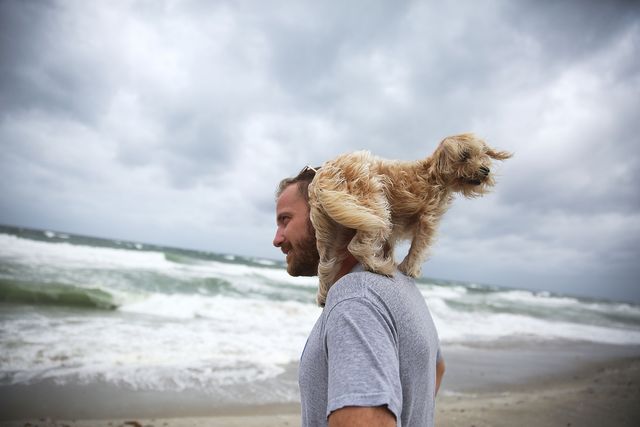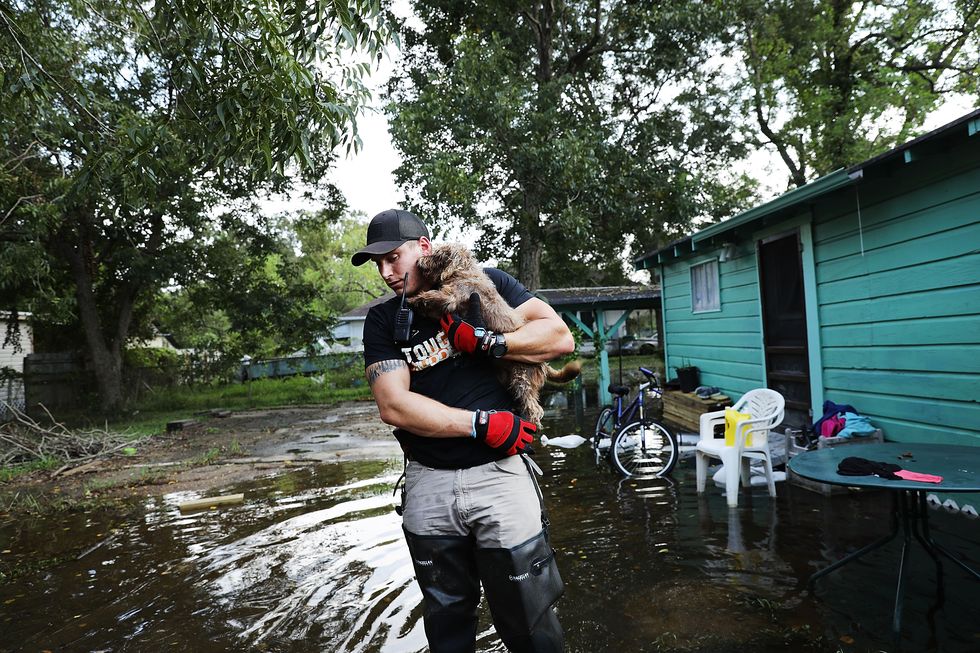Hurricane Florence is currently a Category 4 storm, set to reach North and South Carolina Thursday morning. More than one million people are facing mandatory evacuation orders, CNN reports, and the storm is expected to cause “massive damage” in the region.
When preparing for a hurricane, many people naturally think to stock up on bread and water, and perhaps put up shutters. But some of the most vulnerable victims of hurricanes are pets. Last year, the ASPCA assisted more than 37,000 animals affected by Hurricanes Harvey, Irma, and Maria, plus the wildfires in California. Authorities urge you to not leave your animals behind if you need to evacuate. Here’s what you need to know to keep your pets safe.
Assemble a Pet Emergency Kit
The American Red Cross recommends assembling an emergency kit for your pet, and storing it in sturdy containers in an easy to access location. Luckily, you should have most of the items handy already, so there’s still some time to get it ready for the impending storm.
The kit should include sturdy leashes, harnesses, and/or carriers to safely transport your pet without letting it escape. It should also include food, and if you have a cat that eats wet food, be sure to bring a manual can opener in case there’s no electricity. You should also carry a first aid kit, medications, and medical records in a waterproof container. Some other options include disposable garbage bags, bottled water, and toys.
Other items you might not think of include photos of you with your pets, so you can easily identify your pet in case you get separated. You should also include information for to anyone who needs to take care of your pet if it has to be boarded or fostered; that includes feeding schedules, medical information, behavior problems, and contact information for your veterinarian. Also, make sure your pet is microchipped in case he or she gets lost.
Include Your Pet in Your Evacuation Plan
Once you’ve done that, it’s time to work on an emergency plan for your pet. That includes figuring out what to do with your pet if you need to evacuate your home, giving them collars with correct ID info, and making sure your pet has up-to-date vaccinations—and you have proof of the shots to show a pet shelter.
Evacuating a disaster area with a pet can be complicated, because many shelters don’t allow pets due to health and safety issues. That means you should plan out in advance which hotels or motels accept pets along your evacuation route, and call ahead for reservations if you know you need to evacuate. If a hotel along the route doesn’t accept pets, ask if they can reconsider in case of emergency. (Though online rumors might say so, it’s not required by law for a hotel to accept your pet when you evacuate.) You can also ask your veterinarian for a list of recommended kennels to board your pet.
The ASPCA urges people to never leave their pets behind if they need to evacuate during an emergency. Don’t tether them to poles or trees, either, since that prevents them from getting to safe areas if waters get too high. If you are unable to care for your pet, choose a trusted caregiver outside the evacuation zone who can.
Though this information mainly applies to dogs and cats, the ASPCA also has a list of special considerations if you own horses, birds, reptiles, and small animals. If you care for feral or outdoor cats, the Humane Society has a specific list of what to do in a disaster.
Keep Your Home Safe in a Storm
If you’re not evacuating, the Humane Society recommends you find a safe area of your house where your family and your pets can stay together. Make sure there are no small areas where a cat could try to hide, and move anything dangerous, like chemicals or tools. Make sure any open areas like fireplaces, vents, or pet doors are closed off with plastic sheeting and tape, and that your pet emergency kit is in the room in advance. Then, once authorities announce the storm is about to hit, bring your pets indoors, keeping your dogs on leashes and cats in carriers. Don’t come out until you’re sure it’s safe.
After the storm, don’t let your pets roam loose and keep your pets on leashes or in carriers so they don’t escape. Try to go back to their normal routines as soon as it’s safe, but be ready for potential behavioral issues because of all the stress.
Use Online Resources
You can download a pet safety checklist at the Red Cross’s website. Websites like DogFriendly.com and BringFido.com list pet-friendly hotels across the country. FEMA’s app provides real-time alerts about the weather and locates emergency shelters in your area. And so you’re prepared for next time, the ASPCA offers a free window decal alerting emergency personnel there may be an animal inside your home who needs help.

















